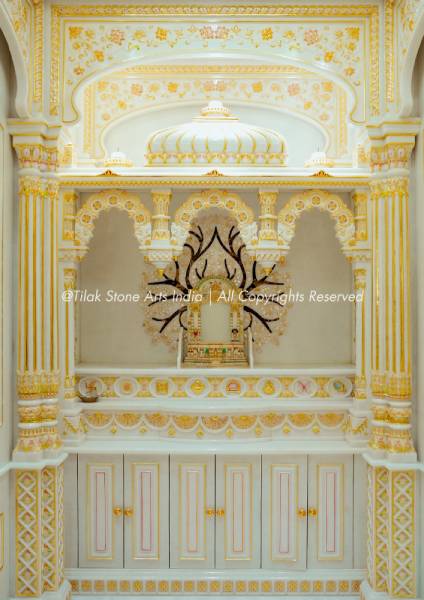Creating a sacred space within your home requires more than selecting beautiful materials and ornate decorations. The ancient science of Vastu Shastra offers profound wisdom for designing pooja rooms that channel positive energy whilst maintaining aesthetic appeal. Modern homeowners increasingly recognise that spiritual spaces demand careful attention to directional placement, material selection, and architectural flow. When these elements align properly, the resulting sanctuary becomes a powerful focal point for daily worship and meditation.
The art of stone temple design for home involves understanding how natural materials interact with cosmic energies according to Vastu principles. Premium stones like Vietnam White Marble naturally enhance spiritual vibrations due to their pure composition and cooling properties. These materials possess inherent qualities that support meditation and prayer, making them ideal foundations for sacred architecture. The subtle energy patterns within quality stone create an environment conducive to spiritual practice. Proper material selection amplifies the benefits of correct directional placement.
The luxury pooja room layouts follow specific Vastu guidelines that have been refined over centuries of spiritual practice. The north-east corner remains the most auspicious location for establishing a prayer space, as this direction receives the first rays of morning sunlight. This positioning allows natural light to illuminate sacred objects throughout the day, creating an atmosphere of divine presence. The gentle morning energy entering from this direction supports peaceful meditation and enhances the spiritual ambiance of the entire space.
Directional Guidelines for Sacred Spaces
North-east placement represents the intersection of divine wisdom and material prosperity in Vastu philosophy. This corner naturally receives cosmic energy that supports spiritual growth and mental clarity during prayer sessions. The positioning should allow devotees to face east or north whilst praying, ensuring alignment with positive energy flows. Avoiding south-west corners prevents the accumulation of negative influences that might disturb spiritual practices. Proper directional orientation forms the foundation upon which all other design elements build.
Material Selection for Spiritual Enhancement
Vietnam White Marble stands out as the premier choice for luxury temple construction due to its exceptional purity and energy-conducting properties. This premium stone maintains consistent temperature, creating a comfortable environment for extended prayer sessions regardless of external weather conditions. The material’s natural lustre reflects light beautifully, amplifying the sacred atmosphere through subtle illumination effects. Quality marble also possesses acoustic properties that enhance the resonance of prayers and chanting. These characteristics make it superior to other materials for creating truly divine spaces.
Architectural Flow and Energy Movement
Vastu principles emphasise the importance of unobstructed energy movement throughout sacred spaces. Doorways should be positioned to allow smooth entry whilst preventing direct sight lines to the deity from common areas of the home. This privacy protection maintains the sanctity of worship whilst ensuring the space remains accessible for daily use. Ceiling heights should be proportionate to floor area, creating a sense of openness without overwhelming the intimate nature of personal prayer. Proper ventilation ensures fresh air circulation, supporting extended meditation sessions.
Sacred Geometry in Design Elements
Traditional proportions guide the placement of various elements within pooja rooms, following mathematical principles that create visual harmony. The ratio between different architectural features should reflect natural proportions found in sacred texts and classical temple architecture. These measurements ensure that the space feels balanced and peaceful rather than cramped or overwhelming. Storage solutions for religious items should be integrated seamlessly into the overall design scheme. Hidden compartments maintain clean lines whilst providing practical functionality for daily worship requirements.
Lighting Considerations for Divine Ambiance
Natural light remains the most beneficial illumination for sacred spaces, supporting both spiritual practice and material preservation. South-facing windows should be avoided, as harsh afternoon sunlight can damage delicate religious artifacts and create uncomfortable prayer conditions. Artificial lighting should complement natural sources without overwhelming the peaceful atmosphere essential for meditation. Warm-toned fixtures create inviting ambiance whilst cooler lighting can support focused study of religious texts. Multiple lighting zones allow adjustment according to different spiritual activities throughout the day.
Colour Psychology in Sacred Interiors
Colour selection significantly impacts the emotional and spiritual atmosphere of pooja rooms. White and light cream tones promote mental clarity and spiritual purity, making them ideal base colours for walls and architectural elements. Soft golden accents can be introduced through decorative elements to enhance the sense of divine presence. Rich colours should be used sparingly in fabrics and artwork to avoid overwhelming the peaceful environment. The overall palette should support concentration and meditation rather than stimulating excessive mental activity.
Integration with Modern Home Design
Contemporary homes require pooja rooms that complement overall interior design whilst maintaining their sacred character. Open-plan living arrangements can accommodate dedicated prayer areas through thoughtful use of screens, level changes, or ceiling treatments that define the sacred zone. Modern storage solutions can be integrated discreetly to accommodate religious items without compromising aesthetic appeal. Technology integration, such as concealed audio systems for playing devotional music, enhances the spiritual experience whilst remaining invisible to maintain design integrity.
Maintenance and Preservation Strategies
Premium materials require specific care protocols to maintain their beauty and spiritual efficacy over time. Vietnam White Marble benefits from regular cleaning with appropriate products that preserve its natural lustre without causing chemical damage. Proper sealing protects against staining whilst maintaining the stone’s ability to regulate temperature naturally. Regular maintenance schedules ensure that the sacred space remains pristine and welcoming for daily worship. Investment in quality materials reduces long-term maintenance requirements whilst preserving spiritual ambiance.
Conclusion
The fusion of ancient Vastu wisdom with contemporary luxury materials creates pooja rooms that serve both spiritual and aesthetic purposes magnificently. These carefully planned spaces become sanctuaries where daily worship transforms into profound spiritual experiences through thoughtful design and premium material selection. Ready to create your perfect sacred space? Consult with experienced designers who understand both Vastu principles and luxury stone craftsmanship to bring your vision to life.
